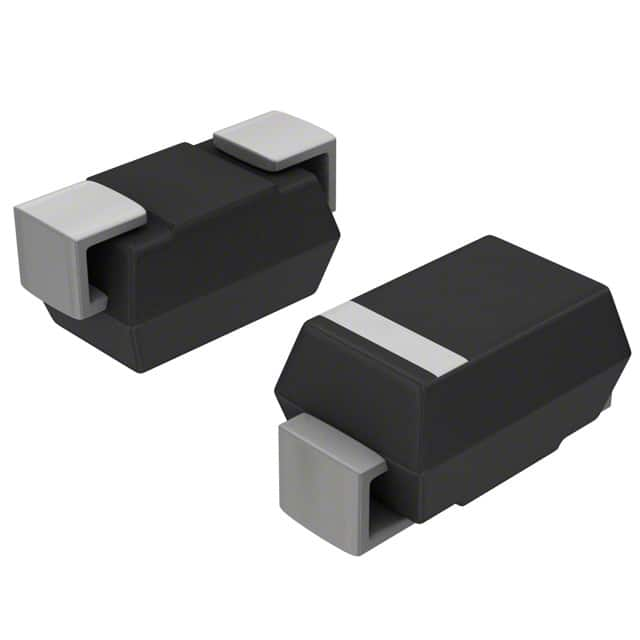SMBJ130AE3/TR13
Product Overview
- Category: Diode
- Use: Voltage suppression in electronic circuits
- Characteristics: Fast response time, low clamping voltage, compact package
- Package: SMB (DO-214AA)
- Essence: Transient Voltage Suppressor (TVS) diode
- Packaging/Quantity: Tape & Reel, 3000 units per reel
Specifications
- Peak Pulse Power: 600 Watts
- Breakdown Voltage: 130V
- Operating Voltage: 111V
- Clamping Voltage: 177V
- Reverse Standoff Voltage: 130V
- Forward Voltage: 1.5V at 10A
- Operating Temperature Range: -55°C to +150°C
Detailed Pin Configuration
The SMBJ130AE3/TR13 has two pins, with the anode connected to the positive side and the cathode connected to the negative side of the circuit.
Functional Features
- Provides protection against transient voltage events
- Fast response time ensures minimal damage to sensitive components
- Low clamping voltage diverts excess current away from the protected circuit
Advantages and Disadvantages
Advantages
- Effective voltage suppression
- Compact size for easy integration into circuits
- Wide operating temperature range
Disadvantages
- Limited to specific voltage ranges
- Requires careful consideration of placement in circuit design
Working Principles
The SMBJ130AE3/TR13 operates by diverting excessive voltage away from sensitive components in a circuit when a transient voltage event occurs. It rapidly clamps the voltage to a safe level, protecting downstream components.
Detailed Application Field Plans
- Telecommunications: Protects communication equipment from lightning-induced surges
- Automotive: Safeguards vehicle electronics from voltage spikes
- Industrial Control Systems: Shields control systems from power surges and transients
Detailed and Complete Alternative Models
- SMBJ110A: Lower breakdown voltage of 110V
- SMBJ150A: Higher breakdown voltage of 150V
- SMBJ170A: Higher breakdown voltage of 170V
This completes the entry for the SMBJ130AE3/TR13, providing comprehensive information on its category, use, characteristics, specifications, pin configuration, functional features, advantages and disadvantages, working principles, application field plans, and alternative models.
10个与SMBJ130AE3/TR13在技术解决方案中的应用相关的常见问题及解答
What is the SMBJ130AE3/TR13?
- The SMBJ130AE3/TR13 is a transient voltage suppressor diode designed to protect sensitive electronic components from voltage spikes and transients.
What is the maximum working voltage of the SMBJ130AE3/TR13?
- The maximum working voltage of the SMBJ130AE3/TR13 is 130V.
What is the peak pulse power dissipation of the SMBJ130AE3/TR13?
- The peak pulse power dissipation of the SMBJ130AE3/TR13 is 600W.
What are the typical applications of the SMBJ130AE3/TR13?
- The SMBJ130AE3/TR13 is commonly used in applications such as power supplies, telecommunications equipment, automotive electronics, and industrial control systems for transient voltage protection.
What is the clamping voltage of the SMBJ130AE3/TR13?
- The clamping voltage of the SMBJ130AE3/TR13 is 209V at 1A.
What is the operating temperature range of the SMBJ130AE3/TR13?
- The SMBJ130AE3/TR13 has an operating temperature range of -55°C to 150°C.
How does the SMBJ130AE3/TR13 provide protection against voltage transients?
- The SMBJ130AE3/TR13 conducts excess current to ground during voltage transients, limiting the voltage across protected components.
Is the SMBJ130AE3/TR13 RoHS compliant?
- Yes, the SMBJ130AE3/TR13 is RoHS compliant, making it suitable for use in environmentally conscious designs.
Can the SMBJ130AE3/TR13 be used for surge protection in power supply units?
- Yes, the SMBJ130AE3/TR13 is well-suited for surge protection in power supply units, helping to safeguard sensitive circuitry from voltage surges.
What are the packaging options available for the SMBJ130AE3/TR13?
- The SMBJ130AE3/TR13 is available in various packaging options, including DO-214AA (SMB) and tape and reel for automated assembly processes.


